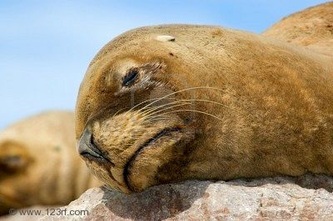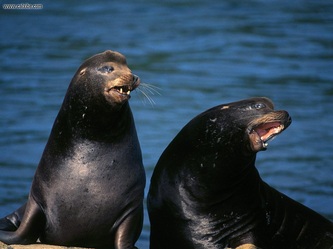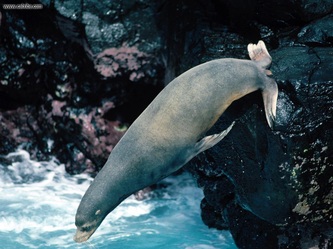Japanese Sea Lion

Lions are generally classified as the Asian lion or the African lion. Both of them have varied physical and social characteristics. But it was the Barbary lion residing in Northern Africa that resembled the Asian lion more than the African lion. Another feature that distinguished the Barbary lion from the rest was that it preferred to dwell in mountainous regions and not in the savanna or open expanses and grassy plains of Africa, or the heavily protected environs of western India. It was separated from the rest of the lion population by deserts on the south, south-east, and east of the Great and Little Atlas. It was also known as the Atlas lion or the Nubian lion. The last Barbary lion in the wild was killed in the Moroccan Atlas Mountains in 1922. Deforestation and encroachment by humans were the other major causes for its extinction from the wild. Two other predators of the Atlas mountain range - the Barbary Leopard and the Atlas Bear are also extinct.
The Barbary lion joined the pantheon of evil predators when they were graphically described in the writings regarding the Roman Empire. Fighting the gladiators and feasting on innocent martyrs. But the extinction of the Barbary lion occurred in stages. It first became extinct in Tripoli in 1700, then in Tunisia due to hunting by Arab and French sportsmen in 1891, in Algeria due to the fact that the Government encouraged tribes to hunt them down in 1899, and finally in Morocco due to the widespread civil war and forest brigands.
The male Barbary lion commonly weighed between 500-600 lbs while the females weighed 300-350 lbs. This is 50% more than what the African lion weighs. Its body was shorter than its Asian and African counterparts but its body could grow up to 11 feet in length. Its legs being shorter contributed to its overall muscular appearance. One distinguishing feature was that its mane extends down the chest through the front legs, through the underside of its belly to the groin. The color of the mane is one of the many variants of blonde depending on the age, sex and physical condition of the lion. Prey included Barbary Stage, gazelle and the Arabic cows. If the opportunity was there then even horses weren’t spared. Carcasses found have indicated that the main method of hunting resembled that of all other lions. It was death by strangulation where the lion would chase down a prey and sink its teeth into the neck. Since it lived in mountain terrain, it had a solitary existence or occasionally lived in pairs. Females raised their young until maturity - approximately 2 years -and then separated from them.
The Barbary lion joined the pantheon of evil predators when they were graphically described in the writings regarding the Roman Empire. Fighting the gladiators and feasting on innocent martyrs. But the extinction of the Barbary lion occurred in stages. It first became extinct in Tripoli in 1700, then in Tunisia due to hunting by Arab and French sportsmen in 1891, in Algeria due to the fact that the Government encouraged tribes to hunt them down in 1899, and finally in Morocco due to the widespread civil war and forest brigands.
The male Barbary lion commonly weighed between 500-600 lbs while the females weighed 300-350 lbs. This is 50% more than what the African lion weighs. Its body was shorter than its Asian and African counterparts but its body could grow up to 11 feet in length. Its legs being shorter contributed to its overall muscular appearance. One distinguishing feature was that its mane extends down the chest through the front legs, through the underside of its belly to the groin. The color of the mane is one of the many variants of blonde depending on the age, sex and physical condition of the lion. Prey included Barbary Stage, gazelle and the Arabic cows. If the opportunity was there then even horses weren’t spared. Carcasses found have indicated that the main method of hunting resembled that of all other lions. It was death by strangulation where the lion would chase down a prey and sink its teeth into the neck. Since it lived in mountain terrain, it had a solitary existence or occasionally lived in pairs. Females raised their young until maturity - approximately 2 years -and then separated from them.
Males and females only came together during the breeding season. Females start coming of age once they are around 2 years old, but do not generally conceive until 3-4 years. Males have the capacity to reproduce at 30 months and but do not tend to produce cubs before the age of 3. Gestation is approximately 110 days, after which 1-6 cubs are born, with 3-4 being most common. The cubs are generally heavily spotted with very dark rosettes and weigh approximately 3.5 pounds at birth.
A DNA analysis of the Asian and African lions would reveal that they are two different sub-species but it is suspected that if such an analysis would be conducted on the Barbary lion we would have a third sub-specie. There are unconfirmed reports that there are a few Barbary lions that exist in captivity in certain North American sanctuaries. Today not more than 15000-20000 lions survive in the wild. If we do not take concrete measures to protest the lion it will not be long that the King of Beasts becomes a folk tale that we narrate to our d
A DNA analysis of the Asian and African lions would reveal that they are two different sub-species but it is suspected that if such an analysis would be conducted on the Barbary lion we would have a third sub-specie. There are unconfirmed reports that there are a few Barbary lions that exist in captivity in certain North American sanctuaries. Today not more than 15000-20000 lions survive in the wild. If we do not take concrete measures to protest the lion it will not be long that the King of Beasts becomes a folk tale that we narrate to our d






 RSS Feed
RSS Feed